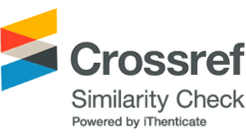Research Article
Achidi, A.U., O.A. Ajayi, B. Maziya-Dixon and M. Bokanga. 2008. The effect of processing on the nutrient content of cassava (Manihot esculenta Crantz) leaves. J Food Process Preserv. 32(3):486-502.
10.1111/j.1745-4549.2007.00165.xAduni, U.A., O.A. Ajayi, M. Bokanga and B.Maziya-Dixon. 2005. The use of cassava leaves as food in africa. Ecol Food Nutr. 44:423-435.
10.1080/03670240500348771Anaeto, M. and L.C. Adighibe. 2011. Cassava root meal as a substitute for maize in layers ration. Rev Bras Cienc Avic. 13(2):153-156.
10.1590/S1516-635X2011000200010Aregheore, E.M. 2012. Nutritive value and inherent anti-nutritive factors in four indigenous edible leafy vegetables in human nutrition in Nigeria: A Review. Journal of Food Resource Science 1(1):1-14.
10.3923/jfrs.2012.1.14Awoyinka, A.F., V.O. Abegunde and S.R. Adewusi. 1995. Nutrient content of young cassava leaves and assessment of their acceptance as a green vegetable in Nigeria. Plant Foods Hum Nutr. 47(1):21-28.
10.1007/BF01088163Baek, Y.C., H. Choi, M. Kim and J.H. Park. 2020. Selection and feed value evaluation of wheat for grain feed at the paddy field in Honam region. JKAIS. 21(3):153-163.
Bradbury, J.H. and I.C. Denton. 2011. Mild methods of processing cassava leaves to remove cyanogens and conserve key nutrients. Food Chem. 127(4):1755-1759.
10.1016/j.foodchem.2011.02.053Bradbury, J.H. and I.C. Denton. 2014. Mild method for removal of cyanogens from cassava leaves with retention of vitamins and protein. Food Chem. 158:417-420.
10.1016/j.foodchem.2014.02.132Chin, Y.W., J.W. Kim, Y.C. Park and J.H. Seo. 2012. Comparison of ethanol fermentation properties between laboratorial and industrial yeast strains using cassava hydrolysate. Korean J. Microbiol. 40(3):220-225.
10.4014/kjmb.1207.07024Choi, Y.H., D.W. Kim and J.S. Kim. 2020. Evaluation of apparent ileal and standardized ileal digestibility of amino acid in feed ingredients to alterate the protein sources for weaned pigs. JKAIS. 21(6):358-365.
Hu, C.J., Q.Y. Jiang, T. Zhang, Y.L. Yin, F.N. Li, J.P. Deng, G.Y. Wu and X.F. Kong. 2017. Dietary supplementation with arginine and glutamic acid modifies growth performance, carcass traits, and meat quality in growing-finishing pigs. J Anim Sci. 95(6):2680-2689.
10.2527/jas2017.1388Hyun, D.H., R. Muhammad, S. Lee, H.C. Ko, S. Oh, M.C. Lee and Y.M. Choi. 2018. Comparison of growth characteristics and flavonoids content by different cultivation seasons in buckwheat germplasm. Korean J. Plant Res. 31(5):489-497.
Kayla, M.H. and P.C. David. 2016. Effects of feeding rumen-degradable valine on milk production in late-lactating dairy cows. J Dairy Sci. 99(2):1201-1215.
10.3168/jds.2015-10197Kim, S.W. 2022. Supplementation of cassava residue level by liquid feeding on growth performance, blood profiles and meat quality in growing-finishing pigs. College of Agriculture and Life Sciences. M.S. Thesis, Seoul National Univ., Korea.
Kwon, S.H. and S. Heo. 2022. Comparison of soil chemical properties in greenhouse or open field where flower crops were cultivated from 2018 to 2020. Korean J. Plant Res. 35(5):675-685.
Laya, A. and B.B. Koubala. 2020. Polyphenols in cassava leaves (Manihot esculenta Crantz) and their stability in antioxidant potential after in vitro gastrointestinal digestion. Heliyon 6(3):e03567.
10.1016/j.heliyon.2020.e03567Li, X., R. Reza, R. Rezaei, P. Li and G. Wu. 2011. Composition of amino acids in feed ingredients for animal diets. Amino Acids. 40(4):1159-1168.
10.1007/s00726-010-0740-ySawittree, C., L. Sajid, M. Busarakorn, K. Pramote, N. Marcus, A. Suwaluk and M. Joachim. 2022. Protein composition, chlorophyll, carotenoids, and cyanide content of cassava (Manihot esculenta Crantz) leaves as influenced by cultivar, plant age, and leaf position. Food Chem. 372:131173.
10.1016/j.foodchem.2021.131173Stupak, M., H. Vanderschuren, W. Gruissem and P. Zhang. 2006. Biotechnological approaches to cassava protein improvement. Trends Food Sci Technol. 17(12):634-641.
10.1016/j.tifs.2006.06.004Tata, S.K., S.B. Hong, S.W. Bae, J.C. Park and S.B. Ryu. 2022. Seasonal variation of rubber production in Russian dandelion, Taraxacum kok-saghyz, Grown in Korea. Korean J. Plant Res. 35(3):399-404.
Wanda, L.B.W., I.A. Diana, M.M. Jennifer and T.S. Richard. 1998. Cyanogenesis in Cassava. Plant Physiol. 116(4):1219-1225.
10.1104/pp.116.4.1219Watana, W., L. Atchara, T. Saowaree, S. Peaingpen and H. Reinhardt. 2018. Cassava variety selection for optimizing the production of leaves to be used as a protein source for animal feed in Thailand. Conference: 14th Symposium of the International Society of Tropical Root Crops, held in Thiruvananthapuram. Kerals, India.
- Publisher :The Plant Resources Society of Korea
- Publisher(Ko) :한국자원식물학회
- Journal Title :Korean Journal of Plant Resources
- Journal Title(Ko) :한국자원식물학회지
- Volume : 37
- No :5
- Pages :439-447
- Received Date : 2024-04-22
- Revised Date : 2024-07-03
- Accepted Date : 2024-07-10
- DOI :https://doi.org/10.7732/kjpr.2024.37.5.439




 Korean Journal of Plant Resources
Korean Journal of Plant Resources







